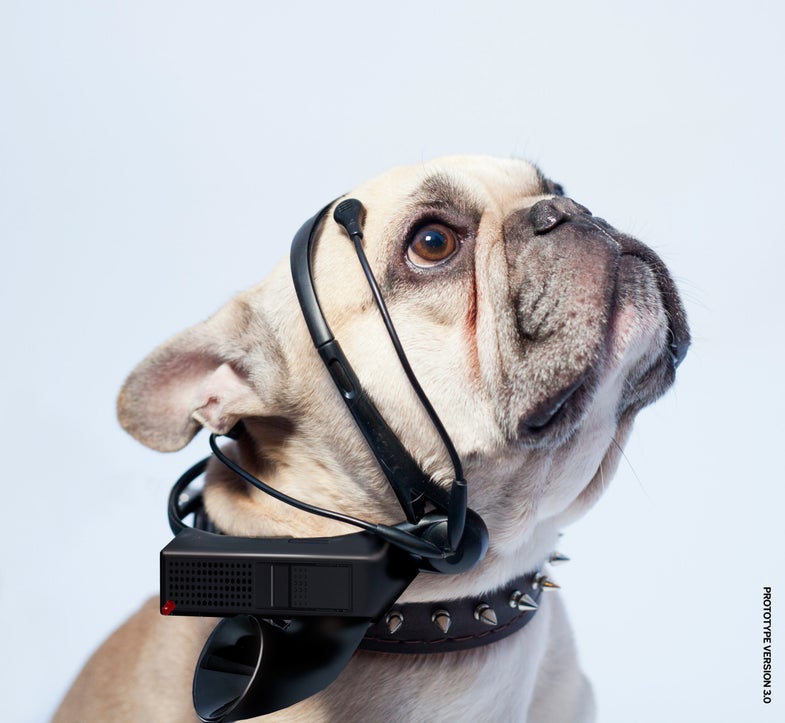This Dog Thought-To-Speech Translator Is Bogus
A new product making the rounds promises to make your dog's brain patterns into human speech. Uh, no.


Making the rounds is the project you see here: a dog-to-speech translator. Put this EEG headset on your dog’s head, and it’ll pick up on its brain waves, then put those scans in plain ol’ English. (I’m hungry, I’m tired, Who are you?) It’s appeared with straight-faced reports on multiple news sites, usually accompanied by this video:
The future! Technology! Hip Scandinavians! A thing that translates your dog’s thoughts into people-speak! Open up your check-book and post-date one for The Future! But wait. Isn’t there something missing in this video? Something important?
Right. It doesn’t show a real demonstration.
Even if it did, it would still be complete, utter bunk. But if it’s a hoax (and the video _almost _makes it seem like some kind of parody) the team behind it is still asking people to pay for the pleasure of using it.
“What I saw in their video can’t work,” says Bruce Luber, associate professor of psychiatry and behavioral sciences at Duke University. Luber specializes in brain stimulation and neurophysiology, trying to do, in some sense, what the people in this video (the Nordic Society for Invention and Discovery) are trying to do: translate what’s happening in the brain directly to behavior. But Luber says it’s not that simple: “We can’t instantaneously tell very much.”
If it worked, the government would be offering money hand-over-fist to fund this.
Some feelings are relatively easy to determine (and this applies to humans as well as animals). Phases of sleep, for example, can _maybe _be determined with only a few scalp electrodes attached to the head. (Although the animal might have to actually be falling asleep for that to be detected.) Feelings like hunger happen deep in the brain–physically deep, as in well below the surface. “You can’t detect hunger, at least as we know it right now, with EEG,” Luber says. Yet both blatantly appear in promotional materials for the headset. And this is actually the most reasonable of the team’s claims: they go on to suggest they’ll offer a more sophisticated device that can let a dog express more complicated emotions. “I’m hungry – but I don’t like this!” for one example. Can’t wait to hear my dog’s dissertation on Lacanian psychoanalysis!
The No More Woof device isn’t even in the same quality zip code as the kinds of advanced electrode arrays (and attached software) researchers like Luber use, which, again, can’t even do most of what this cheap device supposedly could. Animal studies require a bit more finesse, too, than a headset like this would provide. “We go through a whole process–with a monkey, move all the hair out of the way just to make some kind of contact through the head. It doesn’t work with fur.” The device appears to go snugly over your pug’s head, over the fur, which is just about impossible to get accurate readings through. “I’ll just say I’ve never been able to accomplish that,” says Rebecca Packer, associate professor of neurology and neurosurgery at Colorado State University’s College of Veterinary Medicine and Biomedical Sciences.

The promotional material on the No More Woof site makes it all sound so easy–dogs are simple creatures, so it should be easy to figure out what they want. But Packer higlights a few more issues. EEGs aren’t good at looking in-depth into the brain, where mechanisms like hunger would be detected. The spot where you’d pinpoint hunger, for example, is located deep in the hypothalamus, and EEGs are used to pick up measurements that are closer to the brain’s surface, like epileptic activity, Packer says. (But even seizures, which you’d think would be simple to detect, are complicated.) To really do this, you’d need a wearable fMRI or PET scan device–which don’t exist. And it’s even harder to get accurate readings in dogs than it is in people; dogs have thick muscles in the skull that create interference. Even using needle-based electrodes, which can go deeper, it’s extremely hard to get an accurate reading. She also points out that electrical interference causes issues in readings, and trying to read your dog’s mind while it’s running through a home stuffed with gadgets is problematic, to say the least.
Not that it’s doubtful the team will still ship out these headsets; there’s no way for most folks to determine if they actually work. The headset says the dog’s hungry, you put out some food, and the dog eats the food. _Science on the march. _
The team behind No More Woof is asking for money–they’ve started an Indiegogo campaign to fund research and are offering headsets as rewards–but, if it worked, and probably if it even showed legitimate promise, this is the kind of technology companies and the government would be offering money hand-over-fist to fund.
At best, trying to collect money to do research on it is naive. I asked Luber if it would be possible to one day have a device like this.
“If you get DARPA to put about $100 million toward it and get all of us working on it,” he told me.
Which is, of course, the goal. This is the promise of neuroscience: intimately and rapidly understanding ourselves (or dogs). But it’s not even close to that point.
On the project’s Indiegogo page, right next to the other disclaimers–“We’d like to clearly state that the No More Woof is WORK IN PROGRESS”–there’s this: “[T]o be completely honest, the first version will be quite rudimentary. But hey, the first computer was pretty crappy too.” Sure. It also worked.